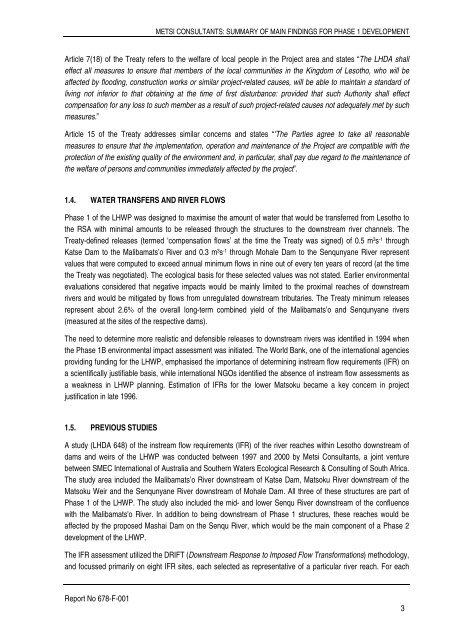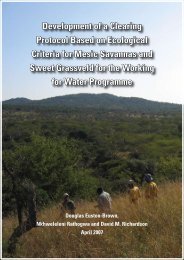Metsi Consultants - DWA Home Page
Metsi Consultants - DWA Home Page
Metsi Consultants - DWA Home Page
You also want an ePaper? Increase the reach of your titles
YUMPU automatically turns print PDFs into web optimized ePapers that Google loves.
Report No 678-F-001<br />
METSI CONSULTANTS: SUMMARY OF MAIN FINDINGS FOR PHASE 1 DEVELOPMENT<br />
Article 7(18) of the Treaty refers to the welfare of local people in the Project area and states “The LHDA shall<br />
effect all measures to ensure that members of the local communities in the Kingdom of Lesotho, who will be<br />
affected by flooding, construction works or similar project-related causes, will be able to maintain a standard of<br />
living not inferior to that obtaining at the time of first disturbance: provided that such Authority shall effect<br />
compensation for any loss to such member as a result of such project-related causes not adequately met by such<br />
measures.”<br />
Article 15 of the Treaty addresses similar concerns and states “'The Parties agree to take all reasonable<br />
measures to ensure that the implementation, operation and maintenance of the Project are compatible with the<br />
protection of the existing quality of the environment and, in particular, shall pay due regard to the maintenance of<br />
the welfare of persons and communities immediately affected by the project”.<br />
1.4. WATER TRANSFERS AND RIVER FLOWS<br />
Phase 1 of the LHWP was designed to maximise the amount of water that would be transferred from Lesotho to<br />
the RSA with minimal amounts to be released through the structures to the downstream river channels. The<br />
Treaty-defined releases (termed ‘compensation flows’ at the time the Treaty was signed) of 0.5 m 3 s -1 through<br />
Katse Dam to the Malibamats’o River and 0.3 m 3 s -1 through Mohale Dam to the Senqunyane River represent<br />
values that were computed to exceed annual minimum flows in nine out of every ten years of record (at the time<br />
the Treaty was negotiated). The ecological basis for these selected values was not stated. Earlier environmental<br />
evaluations considered that negative impacts would be mainly limited to the proximal reaches of downstream<br />
rivers and would be mitigated by flows from unregulated downstream tributaries. The Treaty minimum releases<br />
represent about 2.6% of the overall long-term combined yield of the Malibamats’o and Senqunyane rivers<br />
(measured at the sites of the respective dams).<br />
The need to determine more realistic and defensible releases to downstream rivers was identified in 1994 when<br />
the Phase 1B environmental impact assessment was initiated. The World Bank, one of the international agencies<br />
providing funding for the LHWP, emphasised the importance of determining instream flow requirements (IFR) on<br />
a scientifically justifiable basis, while international NGOs identified the absence of instream flow assessments as<br />
a weakness in LHWP planning. Estimation of IFRs for the lower Matsoku became a key concern in project<br />
justification in late 1996.<br />
1.5. PREVIOUS STUDIES<br />
A study (LHDA 648) of the instream flow requirements (IFR) of the river reaches within Lesotho downstream of<br />
dams and weirs of the LHWP was conducted between 1997 and 2000 by <strong>Metsi</strong> <strong>Consultants</strong>, a joint venture<br />
between SMEC International of Australia and Southern Waters Ecological Research & Consulting of South Africa.<br />
The study area included the Malibamats’o River downstream of Katse Dam, Matsoku River downstream of the<br />
Matsoku Weir and the Senqunyane River downstream of Mohale Dam. All three of these structures are part of<br />
Phase 1 of the LHWP. The study also included the mid- and lower Senqu River downstream of the confluence<br />
with the Malibamats'o River. In addition to being downstream of Phase 1 structures, these reaches would be<br />
affected by the proposed Mashai Dam on the Senqu River, which would be the main component of a Phase 2<br />
development of the LHWP.<br />
The IFR assessment utilized the DRIFT (Downstream Response to Imposed Flow Transformations) methodology,<br />
and focussed primarily on eight IFR sites, each selected as representative of a particular river reach. For each<br />
3

















